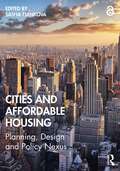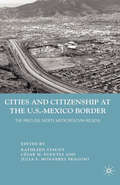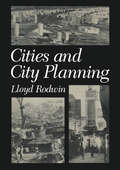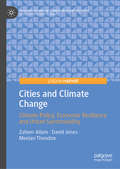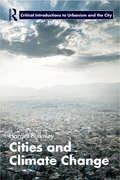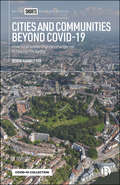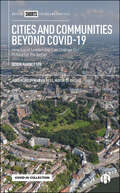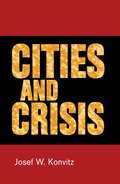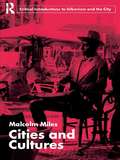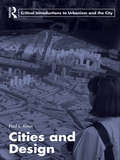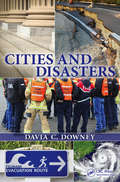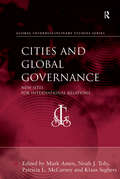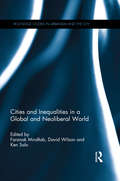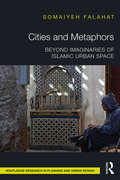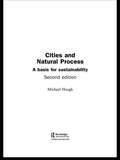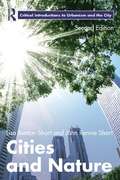- Table View
- List View
Cities and Affordable Housing: Planning, Design and Policy Nexus
by Sasha TsenkovaThis book provides a comparative perspective on housing and planning policies affecting the future of cities, focusing on people- and place-based outcomes using the nexus of planning, design and policy. A rich mosaic of case studies features good practices of city-led strategies for affordable housing provision, as well as individual projects capitalising on partnerships to build mixed-income housing and revitalise neighbourhoods. Twenty chapters provide unique perspectives on diversity of approaches in eight countries and 12 cities in Europe, Canada and the USA. Combining academic rigour with knowledge from critical practice, the book uses robust empirical analysis and evidence-based case study research to illustrate the potential of affordable housing partnerships for mixed-income, socially inclusive neighbourhoods as a model to rebuild cities. Cities and Affordable Housing is an essential interdisciplinary collection on planning and design that will be of great interest to scholars, urban professionals, architects, planners and policy-makers interested in housing, urban planning and city building.
Cities and Affordable Housing: Planning, Design and Policy Nexus
by Sasha TsenkovaThis book provides a comparative perspective on housing and planning policies affecting the future of cities, focusing on people- and place-based outcomes using the nexus of planning, design and policy. A rich mosaic of case studies features good practices of city-led strategies for affordable housing provision, as well as individual projects capitalising on partnerships to build mixed-income housing and revitalise neighbourhoods. Twenty chapters provide unique perspectives on diversity of approaches in eight countries and 12 cities in Europe, Canada and the USA. Combining academic rigour with knowledge from critical practice, the book uses robust empirical analysis and evidence-based case study research to illustrate the potential of affordable housing partnerships for mixed-income, socially inclusive neighbourhoods as a model to rebuild cities. Cities and Affordable Housing is an essential interdisciplinary collection on planning and design that will be of great interest to scholars, urban professionals, architects, planners and policy-makers interested in housing, urban planning and city building.
Cities and Citizenship at the U.S.-Mexico Border: The Paso del Norte Metropolitan Region
by Kathleen Staudt & César M. Fuentes & Julia E. Monárrez FragosoThe volume is a cutting-edge, interdisciplinary approach to analyzing an enormously significant region in ways that clarify the kind of everyday life and work that is generated in a major urban global manufacturing site amid insecurity, inequality, and a virtually absent state.
Cities and City Planning: Changes, Images, And Challenges: 1950-200 (pdf) (Environment, Development and Public Policy: Cities and Development #19)
by Lloyd Rodwin Hugh Evans Robert Hollister Kevin Lynch Michael Southworth Lawrence SusskindCities and Climate Change: Climate Policy, Economic Resilience and Urban Sustainability (Palgrave Studies in Climate Resilient Societies)
by Zaheer Allam David Jones Meelan ThondooThis book explores climate change responsiveness policies for cities and discusses why they have been slow to gain traction despite having been on the international agenda for the last 30 years. The contributing role of cities in accentuating the effects of climate change is increasingly demonstrated in the literature, underscoring the unsustainable models on which urban life has been made to thrive. As these issues become increasingly apparent, there are global calls to adopt more sustainable and equitable models, however doing so will mean the disruption of economies that have historically relied upon pollution-generating industries. In order to address these issues the authors examine them from a cross-disciplinary perspective, bringing in regional, local and urban standpoints to subsequently propose an alternative short-term economic model that could accelerate the adoption of climate change mitigation infrastructures and urban sustainability in urban areas. This book will be of particular value to scholars and students alike in the field of urbanism, sustainability and resilience, as well as practitioners looking at avenues for economically incentivizing sustainable development in various geographical context.
Cities and Climate Change
by Harriet BulkeleyClimate change is one of the most significant global challenges facing the world today. It is also a critical issue for the world’s cities. Now home to over half the world’s population, urban areas are significant sources of greenhouse gas emissions and are vulnerable to the impacts of climate change. Responding to climate change is a profound challenge. A variety of actors are involved in urban climate governance, with municipal governments, international organisations, and funding bodies pointing to cities as key arenas for response. This book provides the first critical introduction to these challenges, giving an overview of the science and policy of climate change at the global level and the emergence of climate change as an urban policy issue. It considers the challenges of governing climate change in the city in the context of the changing nature of urban politics, economics, society and infrastructures. It looks at how responses for mitigation and adaptation have emerged within the city, and the implications of climate change for social and environmental justice. Drawing on examples from cities in the north and south, and richly illustrated with detailed case-studies, this book will enable students to understand the potential and limits of addressing climate change at the urban level and to explore the consequences for our future cities. It will be essential reading for undergraduate students across the disciplines of geography, politics, sociology, urban studies, planning and science and technology studies.
Cities and Climate Change
by Harriet BulkeleyClimate change is one of the most significant global challenges facing the world today. It is also a critical issue for the world’s cities. Now home to over half the world’s population, urban areas are significant sources of greenhouse gas emissions and are vulnerable to the impacts of climate change. Responding to climate change is a profound challenge. A variety of actors are involved in urban climate governance, with municipal governments, international organisations, and funding bodies pointing to cities as key arenas for response. This book provides the first critical introduction to these challenges, giving an overview of the science and policy of climate change at the global level and the emergence of climate change as an urban policy issue. It considers the challenges of governing climate change in the city in the context of the changing nature of urban politics, economics, society and infrastructures. It looks at how responses for mitigation and adaptation have emerged within the city, and the implications of climate change for social and environmental justice. Drawing on examples from cities in the north and south, and richly illustrated with detailed case-studies, this book will enable students to understand the potential and limits of addressing climate change at the urban level and to explore the consequences for our future cities. It will be essential reading for undergraduate students across the disciplines of geography, politics, sociology, urban studies, planning and science and technology studies.
Cities and Communities Beyond COVID-19: How Local Leadership Can Change Our Future for the Better
by Robin HambletonThe COVID-19 virus outbreak has rocked the world and it is widely accepted that there can be no return to the pre-pandemic society of 2019. However, many suggestions for the future of society and the planet are aimed at national governments, international bodies and society in general. Drawing on a decade of research by an internationally renowned expert, this book focuses on how cities and communities can lead the way in developing recovery strategies that promote social, economic and environmental justice. It offers new thinking tools for civic leaders and activists as well as practical suggestions on how we can co-create a more inclusive post COVID-19 future for us all.
Cities and Communities Beyond COVID-19: How Local Leadership Can Change Our Future for the Better
by Robin HambletonThe COVID-19 virus outbreak has rocked the world and it is widely accepted that there can be no return to the pre-pandemic society of 2019. However, many suggestions for the future of society and the planet are aimed at national governments, international bodies and society in general. Drawing on a decade of research by an internationally renowned expert, this book focuses on how cities and communities can lead the way in developing recovery strategies that promote social, economic and environmental justice. It offers new thinking tools for civic leaders and activists as well as practical suggestions on how we can co-create a more inclusive post COVID-19 future for us all.
Cities and crisis
by Josef W. KonvitzCities have been missing from analyses of the global economic crisis and debates about how to generate a sustainable recovery. Cities and crisis provides a fresh assessment of what has changed since 1990 and what has not, of policy assumptions about urban economies, and of lessons of experience. A city-centred strategy to lift urban productivity must reduce deficits of urban innovation and of infrastructure investment: the new limits to growth. The outlook of more frequent and more costly crises to come – environmental, health, and even economic – makes these deficits more alarming. Yet governments seem incapable of setting out a vision for the future of cities. Things may get worse before they get better. We may need radical reforms to get practical solutions to improve urban economic performance and to reduce the impact of urban disasters and crises: our major challenges. Putting cities at the centre of policy will challenge how governments, structured by sectors and levels, work. Paradigm shifts in economic governance have been undertaken successfully in the past; we are just out of practice. Drawing on dozens of reports from the OECD to illuminate recent trends, emerging risks and initiatives to improve decision-making, Cities and crisis is about the future, starting where we are. This book is essential for anyone interested in the lessons of the 2008 crisis for the future of cities in the twenty-first century, and is suitable for classroom use in politics, urban studies, development and business.
Cities and crisis (PDF)
by Josef W. KonvitzCities have been missing from analyses of the global economic crisis and debates about how to generate a sustainable recovery. Cities and crisis provides a fresh assessment of what has changed since 1990 and what has not, of policy assumptions about urban economies, and of lessons of experience. A city-centred strategy to lift urban productivity must reduce deficits of urban innovation and of infrastructure investment: the new limits to growth. The outlook of more frequent and more costly crises to come – environmental, health, and even economic – makes these deficits more alarming. Yet governments seem incapable of setting out a vision for the future of cities. Things may get worse before they get better. We may need radical reforms to get practical solutions to improve urban economic performance and to reduce the impact of urban disasters and crises: our major challenges. Putting cities at the centre of policy will challenge how governments, structured by sectors and levels, work. Paradigm shifts in economic governance have been undertaken successfully in the past; we are just out of practice. Drawing on dozens of reports from the OECD to illuminate recent trends, emerging risks and initiatives to improve decision-making, Cities and crisis is about the future, starting where we are. This book is essential for anyone interested in the lessons of the 2008 crisis for the future of cities in the twenty-first century, and is suitable for classroom use in politics, urban studies, development and business.
Cities and Cultures
by Malcolm MilesCities and Cultures is a critical account of the relations between contemporary cities and the cultures they produce and which in turn shape them. The book questions received ideas of what constitutes a city's culture through case studies in which different kinds of culture - the arts, cultural institutions and heritage, distinctive ways of life - are seen to be differently used in or affected by the development of particular cities. The book does not mask the complexity of this, but explains it in ways accessible for undergraduates. The book begins with introductory chapters on the concepts of a city and a culture (the latter in the anthropological sense as well as denoting the arts), citing cases from modern literature. The book then moves from a critical account of cultural production in a metropolitan setting to the idea that a city, too, is produced through the characteristic ways of life of its inhabitants. The cultural industries are scrutinised for their relation to such cultures as well as to city marketing, and attention is given to the European Cities of Culture initiative, and to the hybridity of contemporary urban cultures in a period of globalisation and migration. In its penultimate chapter the book looks at incidental cultural forms and cultural means to identify formation; and in its final chapter, examines the permeability of urban cultures and cultural forms. Sources are introduced, positions clarified and contrasted, and notes given for selective further reading. Playing on the two meanings of culture, Miles takes an unique approach by relating arguments around these meanings to specific cases of urban development today. The book includes both critical comment on a range of literatures - being a truly inter-disciplinary study - and the outcome of the author's field research into urban cultures.
Cities and Cultures
by Malcolm MilesCities and Cultures is a critical account of the relations between contemporary cities and the cultures they produce and which in turn shape them. The book questions received ideas of what constitutes a city's culture through case studies in which different kinds of culture - the arts, cultural institutions and heritage, distinctive ways of life - are seen to be differently used in or affected by the development of particular cities. The book does not mask the complexity of this, but explains it in ways accessible for undergraduates. The book begins with introductory chapters on the concepts of a city and a culture (the latter in the anthropological sense as well as denoting the arts), citing cases from modern literature. The book then moves from a critical account of cultural production in a metropolitan setting to the idea that a city, too, is produced through the characteristic ways of life of its inhabitants. The cultural industries are scrutinised for their relation to such cultures as well as to city marketing, and attention is given to the European Cities of Culture initiative, and to the hybridity of contemporary urban cultures in a period of globalisation and migration. In its penultimate chapter the book looks at incidental cultural forms and cultural means to identify formation; and in its final chapter, examines the permeability of urban cultures and cultural forms. Sources are introduced, positions clarified and contrasted, and notes given for selective further reading. Playing on the two meanings of culture, Miles takes an unique approach by relating arguments around these meanings to specific cases of urban development today. The book includes both critical comment on a range of literatures - being a truly inter-disciplinary study - and the outcome of the author's field research into urban cultures.
Cities and Design
by Paul L. KnoxCities, initially a product of the manufacturing era, have been thoroughly remade in the image of consumer society. Competitive spending among affluent households has intensified the importance of style and design at every scale and design professions have grown in size and importance, reflecting distinctive geographies and locating disproportionately in cities most intimately connected with global systems of key business services. Meanwhile, many observers still believe good design can make positive contributions to people’s lives. Cities and Design explores the complex relationships between design and urban environments. It traces the intellectual roots of urban design, presents a critical appraisal of the imprint and effectiveness of design professions in shaping urban environments, examines the role of design in the material culture of contemporary cities, and explores the complex linkages among designers, producers and distributors in contemporary cities, for example: fashion and graphic design in New York; architecture, fashion and publishing in London; furniture, industrial design, interior design and fashion in Milan; haute couture in Paris and so on. This book offers a distinctive social science perspective on the economic and cultural context of design in contemporary cities, presenting cities themselves as settings for design, design services and the ‘affect’ associated with design.
Cities and Design
by Paul L. KnoxCities, initially a product of the manufacturing era, have been thoroughly remade in the image of consumer society. Competitive spending among affluent households has intensified the importance of style and design at every scale and design professions have grown in size and importance, reflecting distinctive geographies and locating disproportionately in cities most intimately connected with global systems of key business services. Meanwhile, many observers still believe good design can make positive contributions to people’s lives. Cities and Design explores the complex relationships between design and urban environments. It traces the intellectual roots of urban design, presents a critical appraisal of the imprint and effectiveness of design professions in shaping urban environments, examines the role of design in the material culture of contemporary cities, and explores the complex linkages among designers, producers and distributors in contemporary cities, for example: fashion and graphic design in New York; architecture, fashion and publishing in London; furniture, industrial design, interior design and fashion in Milan; haute couture in Paris and so on. This book offers a distinctive social science perspective on the economic and cultural context of design in contemporary cities, presenting cities themselves as settings for design, design services and the ‘affect’ associated with design.
Cities and Disasters
by Davia Cox DowneyCities and Disasters presents interdisciplinary and multinational perspectives on emergency management policy, economic development, and the various factors that affect the recovery process after natural disasters strike urban areas. The book has three central themes: policy, urbanity, and the interplay of events after disasters that affect the pro
Cities and Global Governance: New Sites for International Relations (Global Interdisciplinary Studies Series)
by Mark Amen Noah J. Toly Patricia L. McCarney Klaus SegbersCase study rich, this volume advances our understanding of the significance of 'the city' in global governance. The editors call for innovation in international relations theory with case studies that add breadth to theorizing the role sub-national political actors play in global affairs. Each of the eight case studies demonstrates different intersections between the local and the global and how these intersections alter the conditions resulting from globalization processes. The case studies do so by focusing on one of three sub-themes: the diverse ways in which cities and sub-national regions impact nation-state foreign policy; the various dimensions of urban imbrications in global environmental politics; or the multiple methods and standards used to measure the global roles of cities.
Cities and Global Governance: New Sites for International Relations (Global Interdisciplinary Studies Series)
by Mark Amen Noah J. Toly Patricia L. McCarney Klaus SegbersCase study rich, this volume advances our understanding of the significance of 'the city' in global governance. The editors call for innovation in international relations theory with case studies that add breadth to theorizing the role sub-national political actors play in global affairs. Each of the eight case studies demonstrates different intersections between the local and the global and how these intersections alter the conditions resulting from globalization processes. The case studies do so by focusing on one of three sub-themes: the diverse ways in which cities and sub-national regions impact nation-state foreign policy; the various dimensions of urban imbrications in global environmental politics; or the multiple methods and standards used to measure the global roles of cities.
Cities and Inequalities in a Global and Neoliberal World (Routledge Studies in Urbanism and the City)
by David Wilson Faranak Miraftab Ken SaloCities continue to be key sites for the production and contestation of inequalities generated by an ongoing but troubled neoliberal project. Neoliberalism’s onslaught across the globe now shapes diverse inequalities -- poverty, segregation, racism, social exclusion, homelessness -- as city inhabitants feel the brunt of privatization, state re-organization, and punishing social policy. This book examines the relationship between persistent neoliberalism and the production and contestation of inequalities in cities across the world. Case studies of current city realities reveal a richly place-specific and generalizable neoliberal condition that further deepens the economic, social, and political relations that give rise to diverse inequalities. Diverse cases also show how people struggle against a neoliberal ethos and hence the open-endedness of futures in these cities.
Cities and Inequalities in a Global and Neoliberal World (Routledge Studies in Urbanism and the City)
by David Wilson Faranak Miraftab Ken E. SaloCities continue to be key sites for the production and contestation of inequalities generated by an ongoing but troubled neoliberal project. Neoliberalism’s onslaught across the globe now shapes diverse inequalities -- poverty, segregation, racism, social exclusion, homelessness -- as city inhabitants feel the brunt of privatization, state re-organization, and punishing social policy. This book examines the relationship between persistent neoliberalism and the production and contestation of inequalities in cities across the world. Case studies of current city realities reveal a richly place-specific and generalizable neoliberal condition that further deepens the economic, social, and political relations that give rise to diverse inequalities. Diverse cases also show how people struggle against a neoliberal ethos and hence the open-endedness of futures in these cities.
Cities and Metaphors: Beyond Imaginaries of Islamic Urban Space
by Somaiyeh FalahatIntroducing a new concept of urban space, Cities and Metaphors encourages a theoretical realignment of how the city is experienced, thought and discussed. In the context of ‘Islamic city’ studies, relying on reasoning and rational thinking has reduced descriptive, vivid features of the urban space into a generic scientific framework. Phenomenological characteristics have consequently been ignored rather than integrated into theoretical components. The book argues that this results from a lack of appropriate conceptual vocabulary in our global body of scholarly literature. It challenges existing theories, introduces and applies the concept of Hezar-tu (‘a thousand insides’) to rethink the spaces in historic cores of Fez, Isfahan and Tunis. This tool constructs a staging post towards a different articulation of urban space based on spatial, physical, virtual, symbolic and social edges and thresholds; nodes of sociospatial relationships; zones of containment; state of intermediacy; and, thus, a logic of ambiguity rather than determinacy. Presenting alternative narrations of paths through sequential discovery of spaces, this book brings the sensual features of urban space into the focus. The book finally shows that concepts derived from local contexts enable us to tailor our methods and theoretical structures to the idiosyncrasies of each city while retaining the global commonalities of all. Hence, in broader terms, it contributes to a growing awareness that urban studies should be more inclusive by bringing the diverse global contexts of cities into the body of our urban knowledge.
Cities and Metaphors: Beyond Imaginaries of Islamic Urban Space
by Somaiyeh FalahatIntroducing a new concept of urban space, Cities and Metaphors encourages a theoretical realignment of how the city is experienced, thought and discussed. In the context of ‘Islamic city’ studies, relying on reasoning and rational thinking has reduced descriptive, vivid features of the urban space into a generic scientific framework. Phenomenological characteristics have consequently been ignored rather than integrated into theoretical components. The book argues that this results from a lack of appropriate conceptual vocabulary in our global body of scholarly literature. It challenges existing theories, introduces and applies the concept of Hezar-tu (‘a thousand insides’) to rethink the spaces in historic cores of Fez, Isfahan and Tunis. This tool constructs a staging post towards a different articulation of urban space based on spatial, physical, virtual, symbolic and social edges and thresholds; nodes of sociospatial relationships; zones of containment; state of intermediacy; and, thus, a logic of ambiguity rather than determinacy. Presenting alternative narrations of paths through sequential discovery of spaces, this book brings the sensual features of urban space into the focus. The book finally shows that concepts derived from local contexts enable us to tailor our methods and theoretical structures to the idiosyncrasies of each city while retaining the global commonalities of all. Hence, in broader terms, it contributes to a growing awareness that urban studies should be more inclusive by bringing the diverse global contexts of cities into the body of our urban knowledge.
Cities and Natural Process
by Michael HoughCities and Natural Process is a book for all concerned with the future of our cities, their design and sustainability, and our quality of life within them. Michael Hough describes how economic and technological values have squeezed any real sense of nature out of the modern city, the ways in which this has led to a divisive separation of countryside and city, wasted much of the city's resources, and shaped an urban aesthetic which is sharply at odds with both natural and social processes. Against this is set an alternative history of ecological values informing proven approaches to urban design which work with nature in the city.
Cities and Natural Process
by Michael HoughCities and Natural Process is a book for all concerned with the future of our cities, their design and sustainability, and our quality of life within them. Michael Hough describes how economic and technological values have squeezed any real sense of nature out of the modern city, the ways in which this has led to a divisive separation of countryside and city, wasted much of the city's resources, and shaped an urban aesthetic which is sharply at odds with both natural and social processes. Against this is set an alternative history of ecological values informing proven approaches to urban design which work with nature in the city.
Cities and Nature (Routledge Critical Introductions to Urbanism and the City)
by Lisa Benton-Short John Rennie ShortCities and Nature connects environmental processes with social and political actions. The book reconnects science and social science to demonstrate how the city is part of the environment and how it is subject to environmental constraints and opportunities. This second edition has been extensively revised and updated with in-depth examination of theory and critical themes. Greater discussion is given to urbanization trends and megacities; the post-industrial city and global economic changes; developing cities and slums; urban political ecology; the role of the city in climate change; and sustainability. The book explores the historical relationship between cities and nature, contemporary challenges to this relationship, and attempts taken to create more sustainable cities. The historical context situates urban development and its impact on the environment, and in turn the environmental impact on people in cities. This provides a foundation from which to understand contemporary issues, such as urban political ecology, hazards and disasters, water quality and supply, air pollution and climate change. The book then considers sustainability and how it has been informed by different theoretical approaches. Issues of environmental justice and the role of gender and race are explored. The final chapter examines the ways in which cities are practicing sustainability, from light "greening" efforts such as planting trees, to more comprehensive sustainability plans that integrate the multiple dimensions of sustainability. The text contains case studies from around the globe, with many drawn from cities in the developing world, as well as reviews of recent research, updated and expanded further reading to highlight relevant films, websites and journal articles. This book is an asset to students and researchers in geography, environmental studies, urban studies and planning and sustainability.
